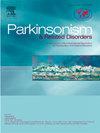贫血、血细胞指数、遗传相关性和大脑结构:帕金森病风险作用的综合分析
IF 3.1
3区 医学
Q2 CLINICAL NEUROLOGY
引用次数: 0
摘要
导言 贫血可能是帕金森病(PD)发病的重要原因。目前关于贫血与帕金森病风险之间关系的研究尚无定论,贫血相关血细胞指标与帕金森病发病率之间的关系需要进一步澄清。本研究旨在通过一项全面的前瞻性队列研究来探讨贫血、血细胞指标与帕金森病风险之间的关系。方法我们使用了英国生物库的数据,这是一项前瞻性队列研究,共有 502,649 名参与者参与,最终有 365,982 名参与者纳入了分析。我们采用了Cox比例危险模型来调整混杂因素,旨在深入探讨贫血和血细胞指数与帕金森病发病风险之间的关系。此外,还研究了贫血与帕金森病多基因风险评分(PRS)之间的交互作用。线性回归和中介分析评估了由大脑结构(包括灰质体积)驱动的潜在机制。贫血大大增加了帕金森病的风险(危险比 [HR] 1.98,95 % 置信区间 [CI]:1.81-2.18,P<0.05):经调整后,贫血大大增加了晚期肾病的风险(危险比 [HR] 1.98,95 % 置信区间 [CI]:1.81-2.18,P < 0.001)。与低PRS参与者相比,贫血高PRS参与者的PD发病率高出83%。敏感性分析证实了结果的可靠性。线性回归显示,贫血与灰质体积和大多数白质束相关。此外,通过中介分析发现,丘脑灰质体积是贫血与脊髓灰质炎风险之间关系的中介。本文章由计算机程序翻译,如有差异,请以英文原文为准。
Anemia, blood cell indices, genetic correlations, and brain structures: A comprehensive analysis of roles in Parkinson's disease risk
Introduction
Anemia may contribute significantly to the onset of Parkinson's disease (PD). Current research on the association between anemia and PD risk is inconclusive, and the relationships between anemia-related blood cell indices and PD incidence require further clarification. This study aims to investigate the relationships between anemia, blood cell indicators, and PD risk using a thorough prospective cohort study.
Methods
We used data from the UK Biobank, a prospective cohort study of 502,649 participants, and ultimately, 365,982 participants were included in the analysis. Cox proportional hazards models were utilized to adjust for confounding factors, aiming to thoroughly explore the associations between anemia and blood cell indices with the risk of incident PD. The interaction between anemia and Polygenic Risk Score (PRS) for PD was also examined. Linear regression and mediation analyses assessed potential mechanisms driven by brain structures, including grey matter volume.
Results
During a median follow-up of 14.24 years, 2513 participants were diagnosed with PD. Anemia considerably increased PD risk (hazard ratio [HR] 1.98, 95 % confidence interval [CI]: 1.81–2.18, P < 0.001) after adjustments. Those with high PRS for anemia had an 83 % higher PD incidence compared to low PRS participants. Sensitivity analyses confirmed result robustness. Linear regression showed that anemia correlated with grey matter volumes and most white matter tracts. Furthermore, mediation analyses identified that the volume of grey matter in Thalamus mediates the relationship between anemia and PD risk.
Conclusion
In summary, we consider there to be a substantial correlation between anemia and increased PD risk.
求助全文
通过发布文献求助,成功后即可免费获取论文全文。
去求助
来源期刊

Parkinsonism & related disorders
医学-临床神经学
CiteScore
6.20
自引率
4.90%
发文量
292
审稿时长
39 days
期刊介绍:
Parkinsonism & Related Disorders publishes the results of basic and clinical research contributing to the understanding, diagnosis and treatment of all neurodegenerative syndromes in which Parkinsonism, Essential Tremor or related movement disorders may be a feature. Regular features will include: Review Articles, Point of View articles, Full-length Articles, Short Communications, Case Reports and Letter to the Editor.
 求助内容:
求助内容: 应助结果提醒方式:
应助结果提醒方式:


